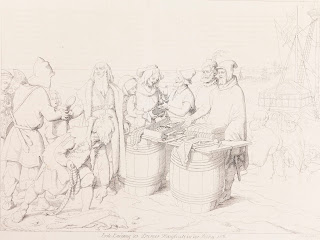https://lcca.lv/en/events/laikmetigas-makslas-izstade--kopiga-vesture-/
The Mouth of Daugava
Friedrich Ludwig von
Maydell (1795 – 1846) was a Baltic-German artist, based in the
region that is now known as Estonia. He produced series of graphic
works that depicted the history of Germans in the eastern shores of
the Baltic sea. Those works were published in albums, titled as
“Fifty Images from the History of Russia’s German Baltic
Provinces”. Here you are witnessing one of these albums, borrowed
from the collection of the Art Museum of Estonia. More precisely, you
are witnessing the work that the artist depicts as the starting event
of the history of the Baltic states – “First Landing of the
Bremen Merchants at the Mouth of the River Daugava. 1156” (1839).
Most of all, this work
speaks about the gaze of the artist as the subject of the modern era,
also as the member of the privileged class in the society based on
slavery. This gaze over the history is similar to the numerous images
that depict the landing of Christopher Columbus in the Caribbean
islands. Maydell portrays the encounter between the Bremen merchants
and the local natives as the act of trade. The image contains some
details that refer to the elements known from the history of European
colonialism. Please find these elements from the image and read the
explanations added by me.
a) Alcohol – the
establishment of the system of dependency and control, used by
colonial powers.
b) Furs – natural
resources and raw materials that are needed by colonizers in places
inhabited by natives.
c) Mirror – the
establishment of the system of representation and validation, also
the production of identity, history, knowledge and subjectivity.
d) Trade beads – the
establishment of the medium of exchange.



No comments:
Post a Comment